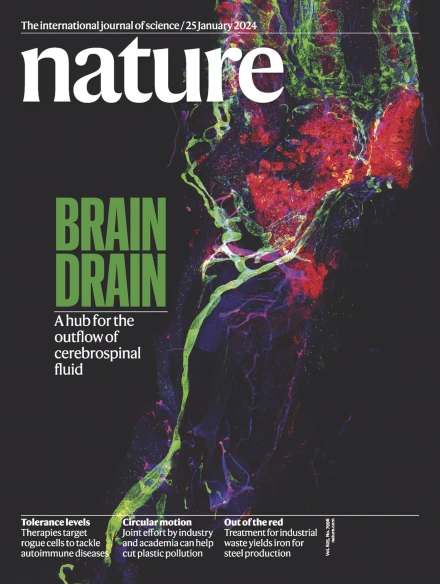Electroluminescence and energy transfer mediated by hyperbolic polaritons
IF 48.5
1区 综合性期刊
Q1 MULTIDISCIPLINARY SCIENCES
引用次数: 0
Abstract
Under high electrical current, some materials can emit electromagnetic radiation beyond incandescence. This phenomenon, referred to as electroluminescence, leads to the efficient emission of visible photons and is the basis of domestic lighting devices (for example, light-emitting diodes)1,2. In principle, electroluminescence can lead to mid-infrared emission of confined light–matter excitations called phonon polaritons3,4, resulting from the coupling of photons with crystal lattice vibrations (optical phonons). In particular, phonon polaritons arising in the van der Waals crystal hexagonal boron nitride (hBN) present hyperbolic dispersion, which enhances light–matter coupling5,6. For this reason, electroluminescence of hyperbolic phonon polaritons (HPhPs) has been proposed as an explanation for the peculiar radiative energy transfer within hBN-encapsulated graphene transistors7,8. However, as HPhPs are locally confined, they are inaccessible in the far field, and as such, any hint of electroluminescence has been based on indirect electronic signatures and has yet to be confirmed by direct observation. Here we demonstrate far-field mid-infrared (wavelength approximately 6.5 μm) electroluminescence of HPhPs excited by strongly biased high-mobility graphene within a van der Waals heterostructure, and we quantify the associated radiative energy transfer through the material. The presence of HPhPs is revealed by far-field mid-infrared spectroscopy owing to their elastic scattering at discontinuities in the heterostructure. The resulting radiative flux is quantified by mid-infrared pyrometry of the substrate receiving the energy. This radiative energy transfer is also shown to be reduced in hBN with nanoscale inhomogeneities, demonstrating the central role of the electromagnetic environment in this process. Far-field mid-infrared spectroscopy reveals both the electroluminescence of hyperbolic phonon polaritons of hexagonal boron nitride excited by strongly biased graphene, and the associated radiative energy transfer through the material.


双曲极化子介导的电致发光和能量传递
在高电流下,有些材料能发出超越白炽的电磁辐射。这种现象被称为电致发光,导致可见光光子的有效发射,是家用照明设备(例如发光二极管)的基础1,2。原则上,电致发光可以导致中红外发射被称为声子极化子的受限光物质激发3,4,这是由光子与晶格振动(光学声子)耦合产生的。特别是,在范德瓦尔斯晶体六方氮化硼(hBN)中产生的声子极化子呈现双曲色散,这增强了光-物质耦合5,6。因此,双曲声子极化子(HPhPs)的电致发光被认为是hbn封装石墨烯晶体管内特殊辐射能量传递的一种解释7,8。然而,由于HPhPs是局部受限的,它们在远场是不可接近的,因此,任何电致发光的暗示都是基于间接的电子签名,尚未得到直接观察的证实。在这里,我们展示了在范德华异质结构中由强偏态高迁移率石墨烯激发的HPhPs的远场中红外(波长约6.5 μm)电致发光,并量化了通过材料的相关辐射能量传递。利用远场中红外光谱分析发现了HPhPs在异质结构不连续处的弹性散射。所得到的辐射通量通过接收能量的衬底的中红外热分析法来量化。这种辐射能量传递在具有纳米级不均匀性的hBN中也被证明是减少的,这表明了电磁环境在这一过程中的核心作用。
本文章由计算机程序翻译,如有差异,请以英文原文为准。
求助全文
约1分钟内获得全文
求助全文
来源期刊

Nature
综合性期刊-综合性期刊
CiteScore
90.00
自引率
1.20%
发文量
3652
审稿时长
3 months
期刊介绍:
Nature is a prestigious international journal that publishes peer-reviewed research in various scientific and technological fields. The selection of articles is based on criteria such as originality, importance, interdisciplinary relevance, timeliness, accessibility, elegance, and surprising conclusions. In addition to showcasing significant scientific advances, Nature delivers rapid, authoritative, insightful news, and interpretation of current and upcoming trends impacting science, scientists, and the broader public. The journal serves a dual purpose: firstly, to promptly share noteworthy scientific advances and foster discussions among scientists, and secondly, to ensure the swift dissemination of scientific results globally, emphasizing their significance for knowledge, culture, and daily life.
 求助内容:
求助内容: 应助结果提醒方式:
应助结果提醒方式:


